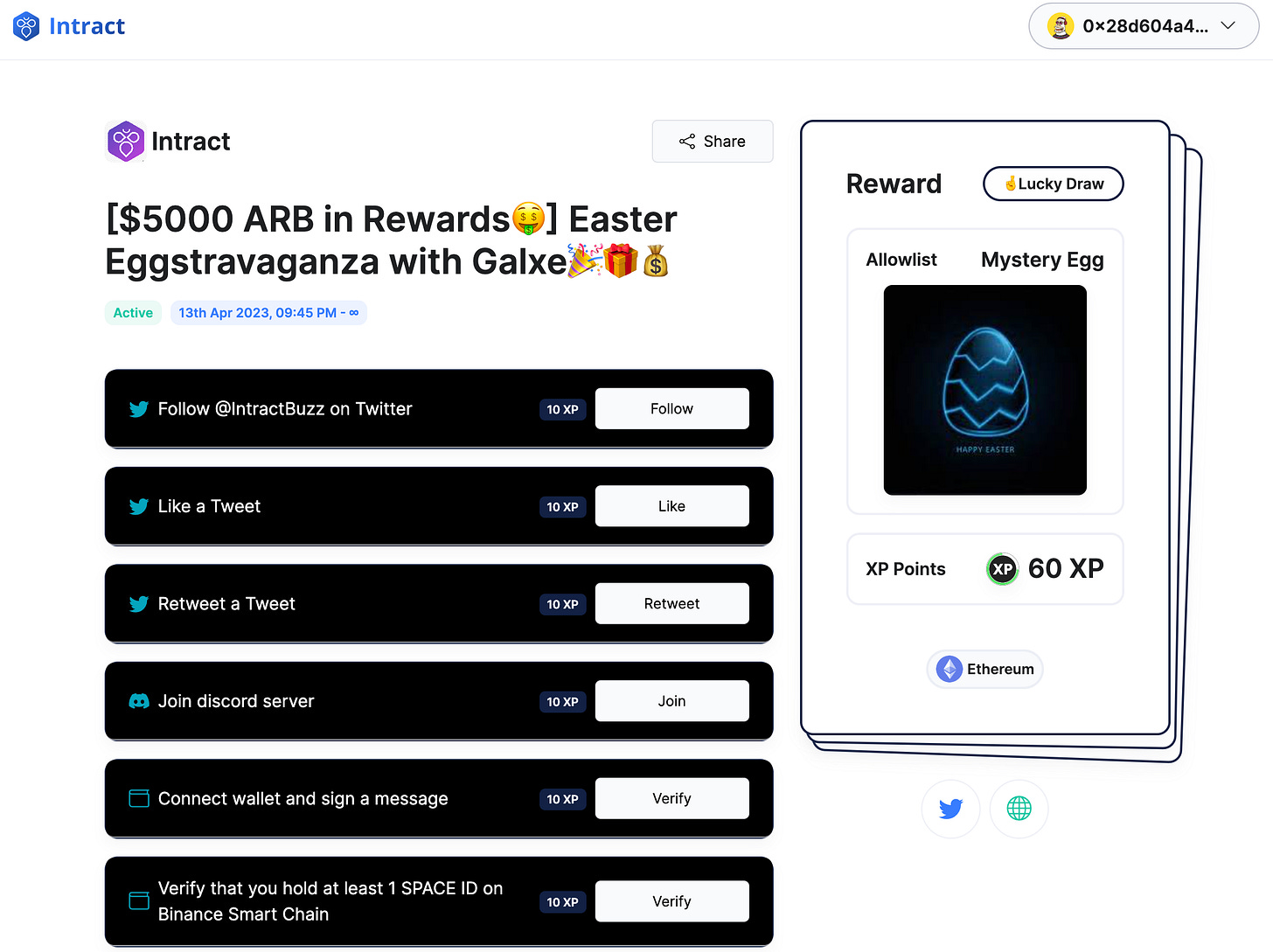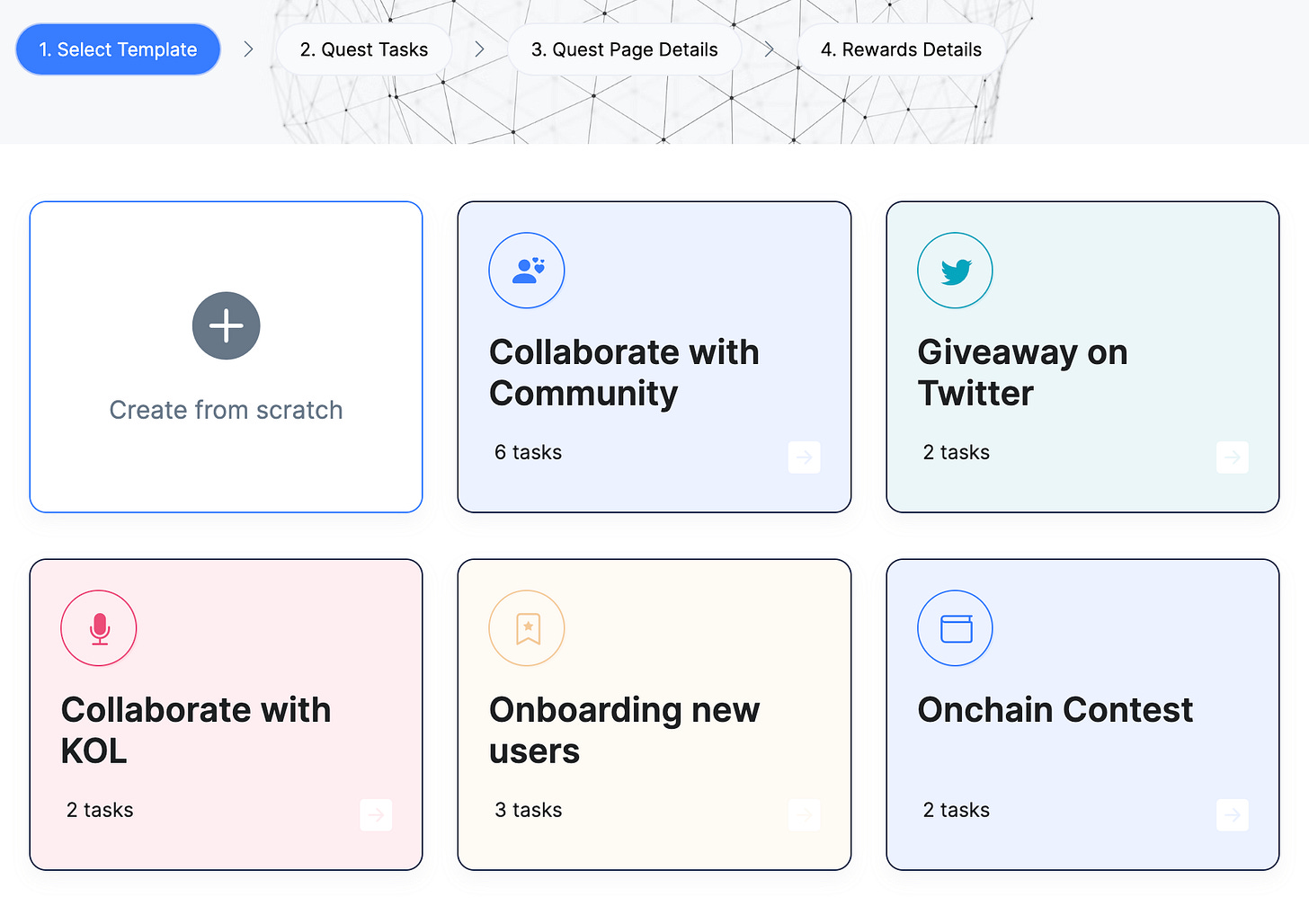#203: Community Engagement Platforms with Sesame Labs and Intract
PLUS: 🎬 I'm starring in Lord of the Rings!
Before we jump into today’s topic…I’m excited to announce that I’m starring in Lord of the Rings!
Pretty convincing, right?! 😂
Yesterday,
shared with me a tool called InsightFace. You can learn more about the bot and add it to your own Discord server here. InsightFace is a fun and simple example highlighting the power of AI, but also shows some potential future concerns. This will be a point of convergence where I believe AI and blockchain will operate symbiotically. 🤖 🤝 ⛓️Community Engagement Platforms
Community engagement in web3 is hard. Whether it’s managing social channels on Twitter, facilitating healthy conversation (or calming angry members) on Discord, or promoting the launch of a new product or initiative, we can all agree that it’s a grind.
Not only is it hard, but what’s the actual impact of these efforts?
I’ve been fortunate to talk to the founders of a couple of up-and-coming web3 marketing platforms that are looking to tackle this exact problem and provide more insight on how they’re doing that.
Sesame Labs
I was introduced to Vinay, the CEO of Sesame Labs, almost a year ago through a mutual contact. I was only a couple months into my own web3 journey writing on this Substack while exploring the the various nooks and crannies of this seemingly infinite space.
Naturally, I was intrigued and curious to learn more about what Vinay and his cofounder Aman were building. Their combined experience at Facebook, Instagram, Whatsapp, and Twitter has led them into this brave new world.
Over the past year, I’ve seen them go from idea to Sesame Labs (while raising $4.5 million in the process), and it’s been a fun to watch them build and iterate upon this platform, while working with clients like Azra Games, Decentral Games, and Premia.
So what are they doing that’s interesting?
First of all, Vinay’s 3-point framework for the problems he’s trying to solve is helpful to understand:
Understanding the community within the context of an on-chain web3 ecosystem
How do they act? How do they interact? What encourages and incentivizes them to take action?
Retaining community members
How do products and companies create engaging campaigns and efforts to get their community involved in a mutually beneficial way? How do these teams ensure that the retained community members are high quality?
Growing the community
What are the right incentivizes to bring more high quality users in?
With that framework, Sesame Labs has built a platform to address these challenges.
From the community member POV
We can see a dashboard with a profile and active Quests. These may range from joining a Discord and verifying membership in it, subscribing to a blog, or referring others to join the Quest.
By completing Quests, members gain experience and level up and earn credits.
There’s a community leaderboard to make things a little more competitive. We all love a little competition, don’t we? 😜
And lastly, there’s a store where community members can redeem their coins for digital and physical goodies.
Taking a peek under the hood
From the Quest creator’s POV, there is a rich set of options to customize and incentivize engagement. For example, let’s say I hypothetically create a giveaway
I can make the Quest open to everyone, or I can filter it based on on-chain data like wallet net worth or NFT/token ownership
Additionally, the milestones to complete the quest can consist of on-chain, off-chain, or in-app events.
Alright, before I continue, let me delete this Quest draft. I do not want to be on the hook for this giveaway, I only have $10 (and a bunch of JPEGs) to my name 😭
Everything I showed is pretty simple and straightforward, right? This is where things get interesting.
Helping marketers through automation
One of Sesame Labs’ focuses is around automation. How can the marketing platform:
Make it easier for Growth and Marketing teams to create engaging Quests that drive incremental impact for the business and back to the community?
Identify what’s actually working?
Sesame is addressing in a few different ways:
Verifying quality: Using image recognition technology to verify and vet for quality. Many communities run meme or art contests, and oftentimes these submissions are copy-pasted from other parts of the Internet.
Dynamic leaderboards: Leaderboards today are usually determined by the amount of Quests and activity completed. The more quests you complete, the higher your score.
However, there are some flaws to this logic, especially if it’s a volume based game. Sesame is taking a holistic approach when it comes to determining the value these actions.
For example, if there is a Quest that requires a tweet, the value of the tweet (measured by engagement: views, likes, retweets, replies) should be considered. Not just the action itself. There are still ways this can be abused, but this does bring us one step closer to determining what quality engagement looks like along with more countermeasures for that abuse.
Additionally, overall activity can be considered across the parameters of recency, frequency, and monetary value.
A community member that completes 100 quests in one week sounds valuable. But how does that compare to a community member that consistently completes 10 quests per week over 10 weeks?
Quest creation: Based on Twitter and Discord content, there is also the opportunity to dynamically create quests. This helps team members to skip the step of Quest creation and focus on Quest refinement.
Spam risk scores: Sesame uses machine learning and on-chain behavior to help score user quality. After all, the web3 world has a lot of farmers (they aren’t farming potatoes, unless it’s a potato token).
Pretty cool, right? Let’s check out Intract and what they’re up to.
Intract
Apurv (Co-Founder of Intract) first reached out to me a few months ago on Discord thanks to my writing.
Since that initial Discord conversation, I’ve had the pleasure of learning more about his company Intract, and what the company has been up to. Intract has raised a $3 million seed round and currently works with over 80 web3 projects in gaming and DeFi.
From the community member POV
Intract has a clean Quest interface, and follows the similar XP and task model.
Campaigns are able to customized with a laundry list of on-chain and off-chain actions as well.
Like Sesame Labs, what gets interesting is also under the hood.
Taking a peek under the hood
I’m a fan of Intract’s dashboard. Clean layout, pretty charts, and numbers highlighting important metrics.
The users view segments the community by the way they have interacted with the community, whether by social channels, Quests, or other methods.
Related to the topic of automation, Intract has a Reporting tool that provides a template of community health. This out of the box view and corresponding insights makes life easier for marketers and covers growth, engagement, activity, and retention views.
Sometimes these tools and corresponding data are spread across multiple vendors (eg: an engagement vendor, retention vendor, etc.). It’s nice to see this included in one comprehensive dashboard.
The campaign analytics view provides deeper insights, breaking down quests by funnel steps and by channel. This helps teams understand where there may be dropoff in engagement efforts and dig into why that might be the case.
Realizing that partnerships and affiliates are an important channel for web3 growth, Intract also has a helpful affiliate tab that focuses on tracking partner performance and a link builder to support that.
Intract also has a multi-channel ROI tracking for these affiliate campaigns, helping teams understand which partners are making a financial impact, going beyond awareness.
Helping marketers through optimization
One of Intract’s focuses is around optimization. How can the marketing platform:
Make it easier for Growth and Marketing teams to understand what efforts are or aren’t working?
Target users with the right incentives and rewards, meeting them where they’re at?
Intract is addressing this in a few different ways for the growth marketer persona they are building for:
Quest templates: With the experience of working with many partners, the team knows what types of Quests work and how to structure them. There is currently a library of 15 Quests and growing.
One-click deployment for rewards: Intract has a tool that allows for efficient rewarding for Questers based on on-chain and off-chain activity. Their dashboards allow for easy analysis to see if the efforts were effective or not.
Offer personalization: The team is working on building a Intelligent Wallet Profiling mechanism. Based on the connected wallet, partners can create custom scenarios and personalized offers to nudge prospective users in the right direction.
If you want to see what else Intract is up to, they have a nifty Loom recording here.
Putting it all together
Engagement and retention are the names of the game, especially in a bear market situation like now. After having several conversations with Sesame and Intract, there are some interesting themes and observations from my end:
What types of companies are more interested in these platforms?
From what I can tell, it seems like web3 gaming and DeFi teams are more interested in these types of products. DeFi is a heavily analytical and quantitative space, while gaming teams (both web2 and web3) have an analytics-heavy culture.
This doesn’t mean your favorite NFT project doesn’t care about analytics. Many, especially the largest ones, do and are beefing up those capabilities. However, it’s more natural for certain verticals to focus on numbers more than feelings, even from Day 1.
There are many players in this space
Sesame and Intract aren’t the only shows in town. Rabbithole, Layer3, and Zealy are also focusing on community engagement and retention. However, each platform focuses on different areas of strength to push their products forward.
Depending on a company’s needs, one platform will be a better option than the others.
The power of on-chain data
By diving into Sesame and Intract’s respective platforms, it’s clear that on-chain data supercharges capabilities in an off-chain only world.
On-chain data provides an additional dimension for analytics, can be combined with off-chain data, and can be remixed to create unique insights (example: a web3 gaming company might learn that their most active users tend to have a wallet value of over $1,000 and have more than 2,000 Twitter followers).
Unique virality mechanics can be tested
This was an idea I came up with Apurv while going over Intract.
A product could create an unannounced airdrop condition. When a user achieves a specific criteria, they are airdropped a reward and are notified.
Once the first (or enough) people receive this airdrop, the word will organically spread and potentially go viral due to the surprise and delight factor.
From that, you can actually measure that viral spark. Who first mentioned the airdrop? How did the virality impact the activity other community members? How does this experimental passive surprise and delight strategy compare to an active announcement strategy?
This could even be layered on top of dynamic conditions where the milestone reached to receive this airdrop is based on the historical activity of that community member.
Shoutout to Sesame Labs and Intract for chatting with me for hours and letting me dig into their respective platforms. I’m looking forward to seeing what comes next for both teams.
See you next week!
























Hey TPan, thanks for covering both of these products in such details. Have been following your newsletter for some time now and love your style with jokes sprinkled around here and there.
Out of curiosity on questing, do you think if the quest is validated by on-chain validators, like L1s have people validating txns, it will increase the trust and attract more suited crowd to these platforms and questing in general?
Awesome blog. Do you think a focus on community re-targeting and content ambassadors can differentiate quest platforms from the ones which already exist, such as Zealy and Layer3?